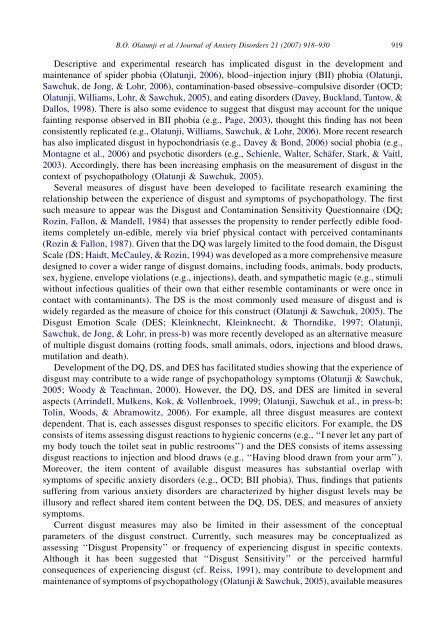The Disgust Propensity and Sensitivity Scale-Revised - University of ...
The Disgust Propensity and Sensitivity Scale-Revised - University of ...
The Disgust Propensity and Sensitivity Scale-Revised - University of ...
- No tags were found...
Create successful ePaper yourself
Turn your PDF publications into a flip-book with our unique Google optimized e-Paper software.
B.O. Olatunji et al. / Journal <strong>of</strong> Anxiety Disorders 21 (2007) 918–930 919Descriptive <strong>and</strong> experimental research has implicated disgust in the development <strong>and</strong>maintenance <strong>of</strong> spider phobia (Olatunji, 2006), blood–injection injury (BII) phobia (Olatunji,Sawchuk, de Jong, & Lohr, 2006), contamination-based obsessive–compulsive disorder (OCD;Olatunji, Williams, Lohr, & Sawchuk, 2005), <strong>and</strong> eating disorders (Davey, Buckl<strong>and</strong>, Tantow, &Dallos, 1998). <strong>The</strong>re is also some evidence to suggest that disgust may account for the uniquefainting response observed in BII phobia (e.g., Page, 2003), thought this finding has not beenconsistently replicated (e.g., Olatunji, Williams, Sawchuk, & Lohr, 2006). More recent researchhas also implicated disgust in hypochondriasis (e.g., Davey & Bond, 2006) social phobia (e.g.,Montagne et al., 2006) <strong>and</strong> psychotic disorders (e.g., Schienle, Walter, Schäfer, Stark, & Vaitl,2003). Accordingly, there has been increasing emphasis on the measurement <strong>of</strong> disgust in thecontext <strong>of</strong> psychopathology (Olatunji & Sawchuk, 2005).Several measures <strong>of</strong> disgust have been developed to facilitate research examining therelationship between the experience <strong>of</strong> disgust <strong>and</strong> symptoms <strong>of</strong> psychopathology. <strong>The</strong> firstsuch measure to appear was the <strong>Disgust</strong> <strong>and</strong> Contamination <strong>Sensitivity</strong> Questionnaire (DQ;Rozin, Fallon, & M<strong>and</strong>ell, 1984) that assesses the propensity to render perfectly edible fooditemscompletely un-edible, merely via brief physical contact with perceived contaminants(Rozin & Fallon, 1987). Given that the DQ was largely limited to the food domain, the <strong>Disgust</strong><strong>Scale</strong> (DS; Haidt, McCauley, & Rozin, 1994) was developed as a more comprehensive measuredesigned to cover a wider range <strong>of</strong> disgust domains, including foods, animals, body products,sex, hygiene, envelope violations (e.g., injections), death, <strong>and</strong> sympathetic magic (e.g., stimuliwithout infectious qualities <strong>of</strong> their own that either resemble contaminants or were once incontact with contaminants). <strong>The</strong> DS is the most commonly used measure <strong>of</strong> disgust <strong>and</strong> iswidely regarded as the measure <strong>of</strong> choice for this construct (Olatunji & Sawchuk, 2005). <strong>The</strong><strong>Disgust</strong> Emotion <strong>Scale</strong> (DES; Kleinknecht, Kleinknecht, & Thorndike, 1997; Olatunji,Sawchuk, de Jong, & Lohr, in press-b) was more recently developed as an alternative measure<strong>of</strong> multiple disgust domains (rotting foods, small animals, odors, injections <strong>and</strong> blood draws,mutilation <strong>and</strong> death).Development <strong>of</strong> the DQ, DS, <strong>and</strong> DES has facilitated studies showing that the experience <strong>of</strong>disgust may contribute to a wide range <strong>of</strong> psychopathology symptoms (Olatunji & Sawchuk,2005; Woody & Teachman, 2000). However, the DQ, DS, <strong>and</strong> DES are limited in severalaspects (Arrindell, Mulkens, Kok, & Vollenbroek, 1999; Olatunji, Sawchuk et al., in press-b;Tolin, Woods, & Abramowitz, 2006). For example, all three disgust measures are contextdependent. That is, each assesses disgust responses to specific elicitors. For example, the DSconsists <strong>of</strong> items assessing disgust reactions to hygienic concerns (e.g., ‘‘I never let any part <strong>of</strong>my body touch the toilet seat in public restrooms’’) <strong>and</strong> the DES consists <strong>of</strong> items assessingdisgust reactions to injection <strong>and</strong> blood draws (e.g., ‘‘Having blood drawn from your arm’’).Moreover, the item content <strong>of</strong> available disgust measures has substantial overlap withsymptoms <strong>of</strong> specific anxiety disorders (e.g., OCD; BII phobia). Thus, findings that patientssuffering from various anxiety disorders are characterized by higher disgust levels may beillusory <strong>and</strong> reflect shared item content between the DQ, DS, DES, <strong>and</strong> measures <strong>of</strong> anxietysymptoms.Current disgust measures may also be limited in their assessment <strong>of</strong> the conceptualparameters <strong>of</strong> the disgust construct. Currently, such measures may be conceptualized asassessing ‘‘<strong>Disgust</strong> <strong>Propensity</strong>’’ or frequency <strong>of</strong> experiencing disgust in specific contexts.Although it has been suggested that ‘‘<strong>Disgust</strong> <strong>Sensitivity</strong>’’ or the perceived harmfulconsequences <strong>of</strong> experiencing disgust (cf. Reiss, 1991), may contribute to development <strong>and</strong>maintenance <strong>of</strong> symptoms <strong>of</strong> psychopathology (Olatunji & Sawchuk, 2005), available measures




